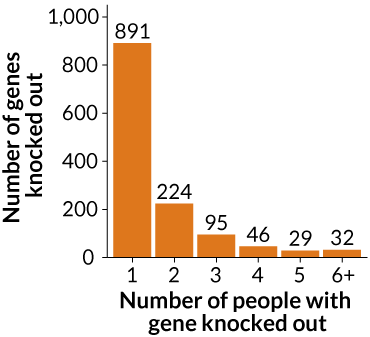
DNA INVESTIGATION Geneticists examined DNA from more than 10,000 people in Pakistan looking for people in whom both copies of certain genes were nonfunctional. High rates of marriage between closely related people there make it more likely that people will inherit two nonfunctional gene copies.
jcamilobernal/iStockphoto
Some Pakistani people are real knockouts, a new DNA study finds. Knockouts in this sense doesn’t refer to boxing or a stunning appearance, but to natural mutations that inactivate, or “knock out” certain genes. The study suggests that human knockouts could prove valuable evidence for understanding how genes work and for developing drugs.
Among 10,503 adults participating in a heart disease study in Pakistan, 1,843 people have at least one gene of which both copies have been knocked out, researchers report online April 12 in Nature. Researchers also drew blood from many of the participants and used medical records to study more than 200 traits, such as heart rate, blood pressure and blood levels of sugar, cholesterol, hormones or other substances. Studying how the knockout mutations affect those traits and health could point to genes that are potentially safe and effective targets for new drugs.
Combining genetic data with medical information will provide “a rich dataset for many applications,” says Robert Plenge, a human geneticist formerly with the pharmaceutical company Merck.
Scientists have traditionally learned about genes’ roles by deleting the genes from mice and then cataloging abnormalities in how those mice developed and behaved. Such animal research will always be needed, but studies of people naturally lacking certain genes “will change the nature of the scientific investigation of the genetic basis of human disease,” Plenge wrote in a commentary in the same issue of Nature.
Often, a person will inherit a broken copy of a gene from one parent and a healthy copy from the other. But 39 percent of the people in this study had parents who were closely related — often first cousins — increasing the odds of inheriting two mutant copies of a gene. Of this study’s 1,843 participants, 1,504 had both copies of a single gene knocked out. The rest had more than one gene knocked out, including one person in whom six genes were predicted to be completely nonfunctional.
In one example from the new study, geneticist Sekar Kathiresan and colleagues found four people in which both copies of the APOC3 gene had inactivating mutations. Kathiresan and colleagues had previously found that people with one mutated copy of APOC3 are protected against heart disease. Normally, the ApoC3 protein made from the gene stops dietary fat from being cleared from the body. People who had one mutant copy of the gene were able to get rid of fat more quickly than normal, reducing the amount left to clog arteries, says Kathiresan, of the Broad Institute of MIT and Harvard. Scientists reasoned that drugs that inactivate the ApoC3 protein would also reduce heart attack risk in people who have two working copies of the gene.
But there was a problem. Scientists worried that drugs that completely abolish the activity of the ApoC3 protein might be dangerous. Previous genetic studies encompassing nearly 200,000 people had never found a person with both copies of APOC3 knocked out, indicating that people might not be able to do without the gene entirely. Finding people who have almost no ApoC3 protein in their blood indicates that it is probably safe to get rid of its activity.
Further tests on 28 family members of one man who had both copies of APOC3 knocked out showed that his wife (who was his first cousin) and all nine of the couple’s children also lacked APOC3. The researchers fed fat-filled milkshakes to 13 members of the family — six who lacked APOC3 and seven who had two functional copies of the gene. Within six hours after the milkshake, levels of triglyceride— a type of fat in the blood — shot up two to three times over premilkshake levels in people with two functional copies of the gene. But in people in which the gene was knocked out, “triglyceride levels didn’t go up. It didn’t budge at all,” Kathiresan says. That finding suggests APOC3 could be a good target for drugs that reduce triglyceride levels in the blood and fend off heart disease, he says.







